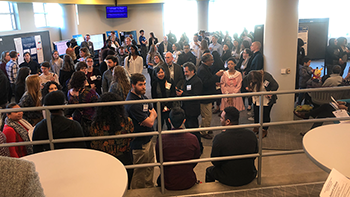Shallow Mucosal Diverticulum of the Esophagus Results in Extensive Pneumoperitoneum - Spontaneous Idiopathic
Description/Abstract/Artist Statement
On July 06, 2018, a 67-year old Caucasian female patient presented to the emergency room with complaints of roughly a 5-day history of mild abdominal pain. During physical examination, there was mild distress, mild firmness and tender to palpation of the abdomen with difficulty to auscultate bowel sounds. The patient’s laboratory tests and vital signs were both unremarkable. There were no associated symptoms of vomiting, nausea or change in bowel motility. Chest X-rays and computed tomography (CT) scan of the abdomen and pelvis both were positive of extensive pneumoperitoneum as well as a gastrointestinal endoscopy was performed and revealed no identifiable sources of the pneumoperitoneum. There was an absence of other signs of sepsis or perforated viscus. She had similar symptoms in 2009 with exploratory laparotomy; laparoscopic Nissen fundoplication yielding no identifiable pathology that is consistent with idiopathic spontaneous pneumoperitoneum. On July 11, 2018 the patient’s symptoms were unresponsive to medical management, with results of increased abdominal discomfort. Exploratory laparotomy was recommended due to the concern of possible evolution into a full-blown abdomen surgery. Post-operative diagnosis revealed a shallow mucosal diverticulum of the esophagus which was most likely the source for the patient’s confirmed diagnosis of pneumoperitoneum. Following corrective surgery of the diverticulum, the patient was instructed to make life-style changes including dietary and exercise alterations with cessation of tobacco use to reduce the probability of pneumoperitoneum recurrence.
Faculty Advisor/Mentor
Lisa Byrum
Presentation Type
Poster
Disciplines
Anatomy | Anesthesiology | Family Medicine | Gastroenterology | Internal Medicine | Medical Education | Medical Pathology | Medical Sciences | Medicine and Health Sciences | Osteopathic Medicine and Osteopathy | Other Medical Specialties | Primary Care | Respiratory System | Surgery
Session Title
Poster Session
Location
Learning Commons, Atrium
Start Date
2-8-2020 8:00 AM
End Date
3-2-2020 12:30 PM
Shallow Mucosal Diverticulum of the Esophagus Results in Extensive Pneumoperitoneum - Spontaneous Idiopathic
Learning Commons, Atrium
On July 06, 2018, a 67-year old Caucasian female patient presented to the emergency room with complaints of roughly a 5-day history of mild abdominal pain. During physical examination, there was mild distress, mild firmness and tender to palpation of the abdomen with difficulty to auscultate bowel sounds. The patient’s laboratory tests and vital signs were both unremarkable. There were no associated symptoms of vomiting, nausea or change in bowel motility. Chest X-rays and computed tomography (CT) scan of the abdomen and pelvis both were positive of extensive pneumoperitoneum as well as a gastrointestinal endoscopy was performed and revealed no identifiable sources of the pneumoperitoneum. There was an absence of other signs of sepsis or perforated viscus. She had similar symptoms in 2009 with exploratory laparotomy; laparoscopic Nissen fundoplication yielding no identifiable pathology that is consistent with idiopathic spontaneous pneumoperitoneum. On July 11, 2018 the patient’s symptoms were unresponsive to medical management, with results of increased abdominal discomfort. Exploratory laparotomy was recommended due to the concern of possible evolution into a full-blown abdomen surgery. Post-operative diagnosis revealed a shallow mucosal diverticulum of the esophagus which was most likely the source for the patient’s confirmed diagnosis of pneumoperitoneum. Following corrective surgery of the diverticulum, the patient was instructed to make life-style changes including dietary and exercise alterations with cessation of tobacco use to reduce the probability of pneumoperitoneum recurrence.


